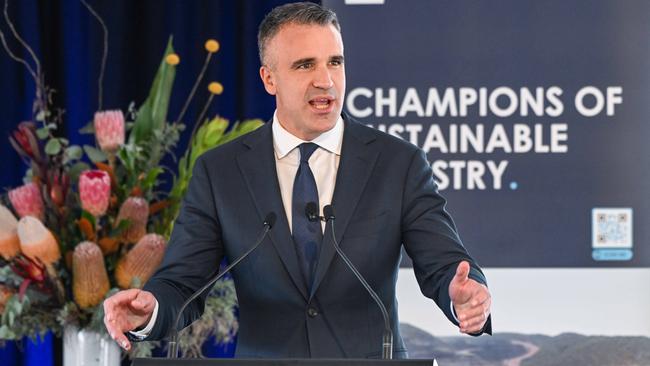Nuclear power versus green hydrogen in electricity price war
With billions of dollars of taxpayers’ money at stake and power prices soaring, climate wars are set to reignite. Paul Starick explains why.
Opinion
Don't miss out on the headlines from Opinion. Followed categories will be added to My News.
A new divide has opened in the long-running climate wars – the cost of Australia’s clean energy transition.
Hydrogen energy is the weapon chosen by Labor – in power almost everywhere across the country.
Nuclear power is now a centrepiece of the Liberal bid to fight back from electoral defeat and a subsequent quest for relevance.
South Australia is at the heart of this battle, because Labor has been in the thrall of hydrogen’s potential for some years and has promised a $593m hydrogen power plant near Whyalla.
On the other hand, at least eight nuclear-powered submarines will be built in Adelaide as part of the AUKUS security pact, using a reactor supplied by United Kingdom-based Rolls-Royce Submarines.
Opposition Leader Peter Dutton tried to skewer this contradiction in his federal budget reply speech on Thursday night, arguing any sensible government must consider small modular nuclear power as part of the energy mix, given 32 countries use the zero-emission fuel.
“Next-generation, small modular nuclear technologies are safe, reliable, cost-effective, can be plugged into existing grids where we have turned off coal and emit zero emissions,” he said.
“Oddly, Labor is happy for similar technologies to power our future submarines but it refuses to consider the benefits of onshore small and micro modular reactors.”
Prime Minister Anthony Albanese swiftly rebuffed Premier Peter Malinauskas last December when he opened the door to nuclear power.
In an interview with The Advertiser, Mr Malinauskas argued the Osborne Naval Shipyard nuclear-powered submarine construction would bust “ill-founded” ideological myths about atomic safety and demonstrate safety concerns were based on decades-old sentiment.
“Nuclear power is a source of base load energy with zero carbon emissions. So, for someone like myself, who is dedicated to a decarbonisation effort, I think we should be open-minded to those technologies and I think it would be foolhardy to have a different approach,” Mr Malinauskas said, with the important caveat that cost was a prohibitive barrier to Australia embracing the technology.

Asked on FIVEaa radio about the Premier’s nuclear comments, Mr Albanese declared: “Well, it just doesn’t add up. That’s essentially the problem. Every five years or so we have this economic analysis of whether nuclear power stacks up and every time it’s rejected.”
Labor has put its cards firmly on the green hydrogen table. This involves the production of hydrogen using renewable energy, particularly wind and solar.
Mr Malinauskas on Thursday delivered the keynote address at the World Hydrogen Summit in the Dutch port city of Rotterdam, where he touted SA as “already a world leader when it comes to renewable energy”.
He detailed a Hydrogen and Renewable Energy Act, designed to “make it as easy as possible for companies to invest in our state”.
One of the key policies he took to the 2022 state election was a $593m hydrogen power plant at Whyalla.
Mr Malinauskas billed the hydrogen jobs plan as a centrepiece of his economic strategy.
The plan had three elements: a 200MW power station, hydrogen electrolysers with 250MWe capacity, and a hydrogen storage facility holding two month’s supply, or 3600 tonnes.
Unveiling a $2bn Hydrogen Headstart program in Tuesday’s federal budget, Treasurer Jim Chalmers said: “Hydrogen power means Wollongong, Gladstone and Whyalla can make and export everything from renewable energy to green steel.”
The 29 proposals to co-invest in Labor’s Whyalla hydrogen plant are being evaluated and contracts are expected within months.
Crunch time is approaching on whether the hydrogen vision becomes reality.





